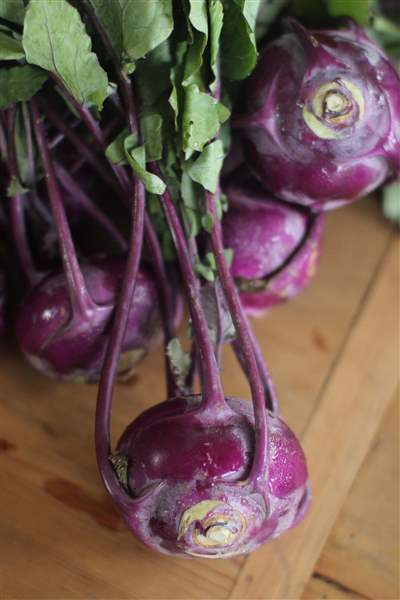
HOME & GARDEN
Hardy vegetables can extend growing into late fall
9/4/2018
Kohlrabi, a member of the cabbage family, is a vegetable that survives in cold weather.
ASSOCIATED PRESS
Even though summer’s heat is stubborn, everyone knows that the leaves will turn and fall and the frost will come.
So gardeners put away the garden hose, pluck their last tomatoes, and trade in their hoes for snow shovels, because plants don’t like the cold.
Just try to tell that to the swiss chard, snowpeas, spinach, and the hardy members of the cabbage family.
“I’ve harvested spinach in the snow,” said Bryan Ellis, instructor at the Natural Science Technology Center of Toledo Public Schools. “Often your spinach will overwinter and be the first thing to pop out in the spring.”
Mary Machon, owner of Bensell Greenhouse, said many things can grow and thrive in the cooler weather. In fact, some plants, like the swiss chard, wilt in the heat.
“A lot of people think only of lettuce; all of your root vegetables can survive as well,” she said.
Other than lettuce, other vegetables that can withstand a light frost are arugula, fennel, beets, broccoli, brussel sprouts and cabbage, radishes, collards, turnips, carrots, onions, cauliflower, some celery, chard, fennel, kohlrabi, turnips, and many others.
You will, however, have to say good-bye to your cucumbers, tomatoes, and squash, Mr. Ellis said.
“Most people have had enough of zucchini and cherry tomatoes,” he joked.
Some vegetables, like collard greens, even taste better after a light frost, Mr. Ellis said.
But the window for planting these veggies is closing, Ms. Machon said, and weather isn’t the only culprit.
“You have to look at days to maturity when you plant,” she said. “In Toledo we can have have an early frost but a 60-degree day.”
Ms. Machon said that when choosing these plants or even seeds, check the days till maturity, because the shorter days of the sun’s life-giving light will not nourish the plants.
Don’t put planting off, especially with slower maturing crops.
For example, a radish takes about 30 days to reach maturity.
“You could be growing them now,” she said.
Mr. Ellis agreed that time is of the essence. “Right now we’re still going to be in the 90s, and the soil gives off energy all night long,” he said. “You can start getting some stuff going, swiss chards, kales. We’re not going to be experiencing 90-degrees a month from now.”
In our corner of northwest Ohio, cold is bound to happen. That doesn’t mean you can’t have fresh carrots for your Thanksgiving dinner, Ms. Machon said.
With a little tender, loving care and some imagination, gardeners can extend the season.
“If there’s a chance of frost, get a sheet out of the linen closet and throw it over your plants,” Ms. Machon said.
Plastic can be used if the plants don’t come into direct contact with it.
“Plastic is a conductor of cold,” she said.
Sister Rita Wienkin, urban farm coordinator with Toledo GROWs, knows how to construct a simple cold frame for her raised beds and garden plots.
“Envison a mini greenhouse or think of a 4-by-8 raised bed; picture small hoops with plastic over that,” Sister Rita said. For the hoops, she said, use “either waterlined plastic like you use for pumbing, or some people use metal and use a bending tool.”
She said, though, while hardy produce will survive, they won’t get overly big simply because of the shorter days.
But shorter days and cooler weather bring another benefit besides fresh produce for Thanksgiving dinner; fighting pests will be easier and watering duties not as intense as it is in the summer.
Ms. Machon of Bensell says gardeners will need to still watch out for slugs, especially in the damp cold, but the cabbage moths are dying off.
Plus, plants require less water in the cooler weather than in the intense heat. Resist the urge to put the garden hose away, she said, but it won’t be needed as much.
Research and planning are vital to the garden’s success any time of the year, Mr. Ellis said.
“Biggest thing is to start with the right plants, good healthy plants,” Mr. Ellis said. “Go with someone locally to pick them up and go with advice from your local garden center” or even reliable sources on the Internet.
So stop pulling out your plants and get back to planting, Ms. Machon said. With careful planting, the gardening season can extend to nine months out of the year’s 12.
“It’s not over,” she said.
Remember those fresh veggies from you own garden for Thanksgiving dinner, and possibly beyond.
Contact Heather Denniss at: hdenniss@theblade.com